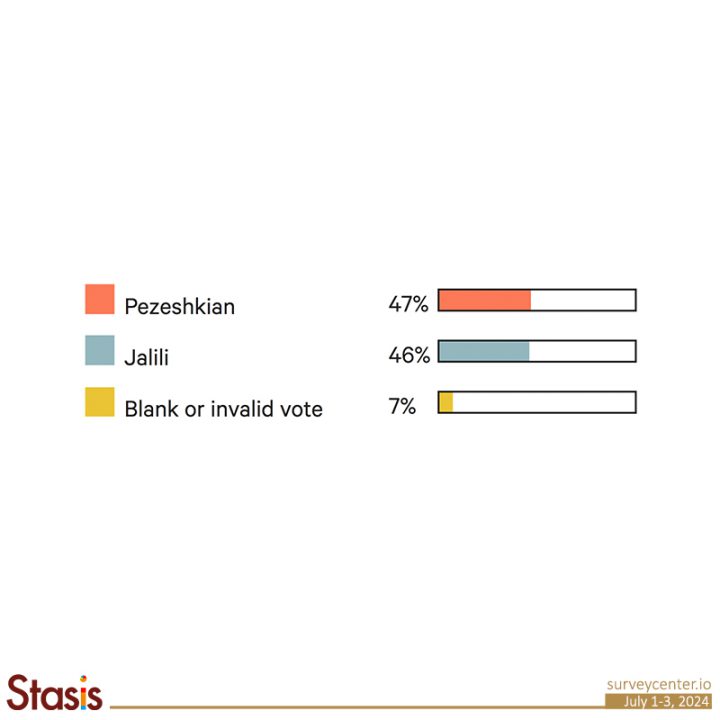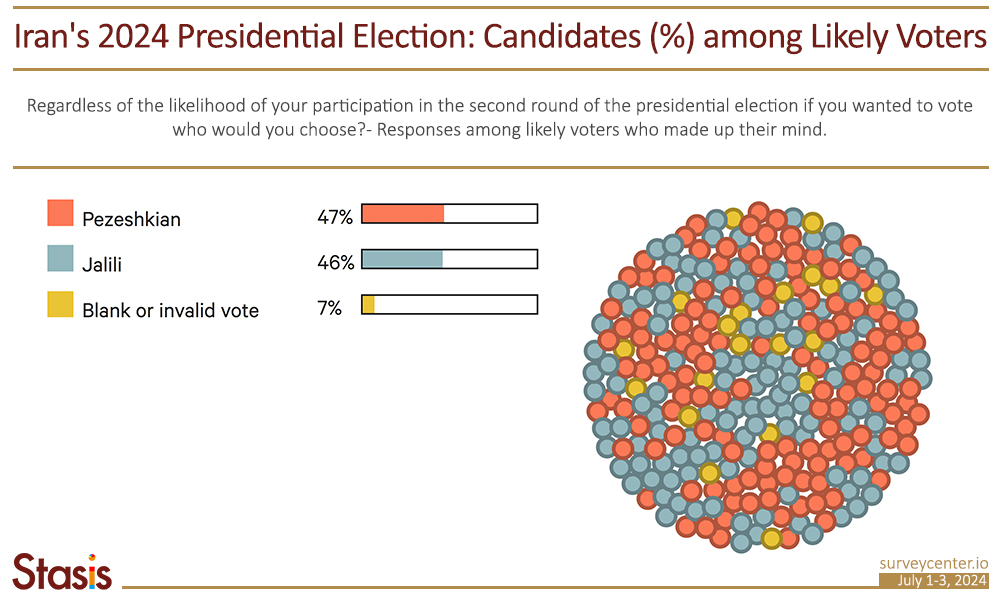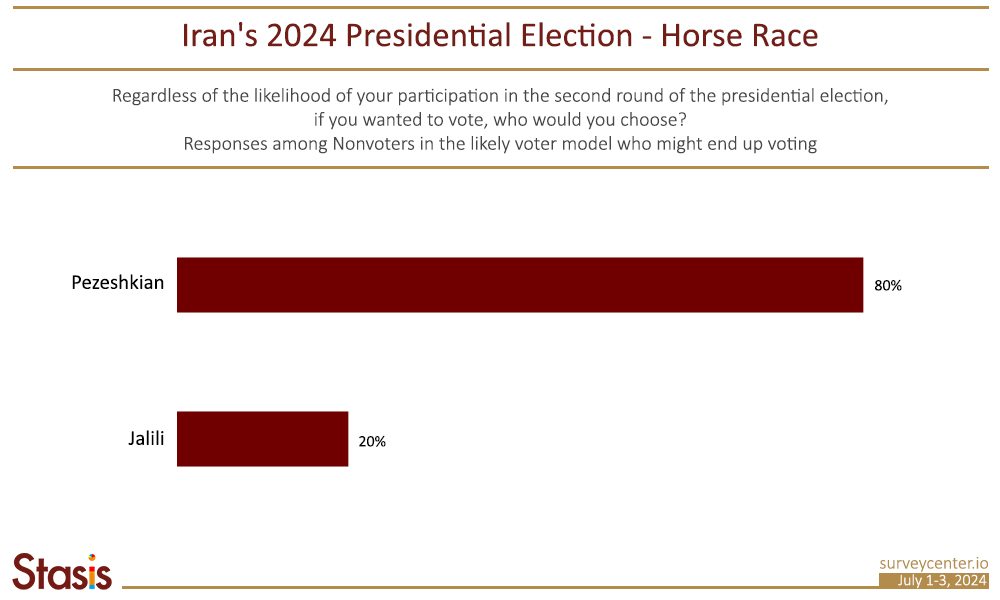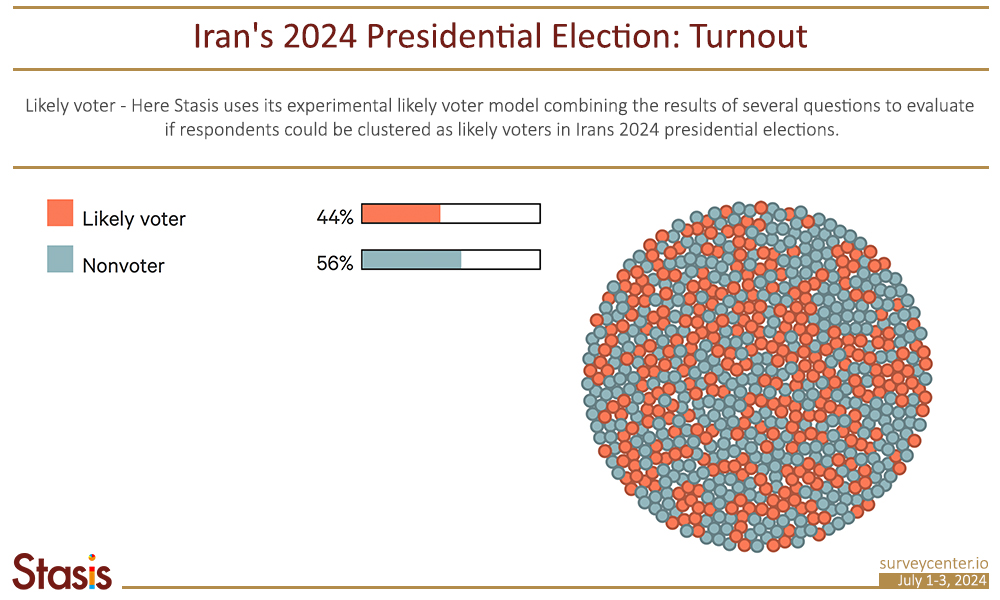
Iran’s 2024 Dead-Heat Presidential Election
The reformist and hardliner candidates are neck-and-neck in Iran’s runoff election, according to the latest poll by Stasis Consulting. Around 47% of likely voters support the Reformist Masoud Pezeshkian as opposed to 46% of the electorate who prefer a hardliner, Saeed Jalili. The poll conducted between July 1 and July 3, 2024, also found that approximately 44% of Iranian citizens will participate in the second round of the presidential election.
Reformist Candidate has a Slight Edge over his Hardliner Contender
According to final Stasis’ poll, a reformist candidate, Masoud Pezeshkian has a slight edge over his hardliner contender, Saeed Jalili (47% to 46%) in the second round of Iran’s 2024 presidential election.

According to this poll, around 13% of potential likely voters are still undecided as to how they might cast their ballot, and 20% of the electorate are considering whether they should participate in the election (the latter are excluded from the poll’s likely voters’ designation and are considered as nonvoters in the model). The election’s result depends significantly on these 20% of the electorate. Mr. Pezeshkian’s presidency hinges chiefly upon increased turnout and participation by a part of the electorate that says they won’t vote but were they to, they would have cast a ballot in favor of Mr. Pezeshkian 4 to 1.

In the first round of the election, Mr. Pezeshkian beat his two main Principlist rivals, Mr. Jalili and Mr. Qalibaf. However, since no candidate exceeded the 50 percent threshold, the top two candidates are facing off this Friday July 6, 2024.
Election Turnout
Stasis predicts that the participation rate will be around 44%, based on the firm’s likely voter model, which was adjusted after incorrectly estimating the first-round election turnout. In the first round, Stasis predicted a 50% participation rate, which turned out to be 40%.

Remarks
The results of this poll have been interactively visualized in this link. This is an interactive platform detailing the results of every question, distinguished by gender, age group, location, and education in a bar chart.
For each question, there is a bubble chart (consisting of many small circles), detailing the respondents’ information. Each circle represents a single respondent and by clicking on it, you can find the complete answer set for that particular respondent. The color coding is consistent between the bubble chart and bar chart for easy comparison.
Stasis predicts that the participation rate will be around 44%, based on the firm’s likely voter model, which was adjusted after incorrectly estimating the first-round election turnout.
Stasis uses our proprietary likely voter model, analyzing responses to different questions to identify probable voters. Criteria for likely voters include a) knowing (exactly or approximately) the election date, b) saying that they are very likely to participate in the election, and c) not saying “I don’t know” or refusing to answer the question about the likelihood of their participation in the election.
Methodology
- Telephone interviews were conducted between July 1 and July 3, 2024, with a random sample of 741 Iranians aged 18 and older living in Iran. Native Farsi speakers conducted the interviews during daylight hours.
- The proportional two-stage sample includes respondents from every province. Provinces have been sampled based on their population.
- Results are weighted by gender, age, location (urban vs. rural areas), based on the Iranian national census of 2016, the 2018 statistical yearbook, and demographic predictions from Iran’s Statistical Center for the year 2024.
- Based on the sample, there is a 95% confidence that the margin of sampling error is ± 3.8 percentage points (likely voters excluded).
- Rates of respondent candor and reliability were appraised by experienced interviewers
- This poll was carried out by Stasis in association with the Middle East Institute.
The response rate for this survey was 43.4%.